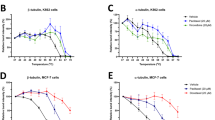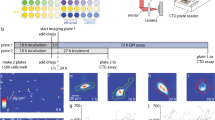Abstract
Quantitation of drug target engagement in single cells has proven to be difficult, often leaving unanswered questions in the drug development process. We found that intracellular target engagement of unlabeled new therapeutics can be quantitated using polarized microscopy combined with competitive binding of matched fluorescent companion imaging probes. We quantitated the dynamics of target engagement of covalent BTK inhibitors, as well as reversible PARP inhibitors, in populations of single cells using a single companion imaging probe for each target. We then determined average in vivo tumor concentrations and found marked population heterogeneity following systemic delivery, revealing single cells with low target occupancy at high average target engagement in vivo.
This is a preview of subscription content, access via your institution
Access options
Subscribe to this journal
Receive 12 print issues and online access
$259.00 per year
only $21.58 per issue
Buy this article
- Purchase on Springer Link
- Instant access to full article PDF
Prices may be subject to local taxes which are calculated during checkout




Similar content being viewed by others
References
Bunnage, M.E., Chekler, E.L. & Jones, L.H. Target validation using chemical probes. Nat. Chem. Biol. 9, 195–199 (2013).
Morgan, P. et al. Can the flow of medicines be improved? Fundamental pharmacokinetic and pharmacological principles toward improving Phase II survival. Drug Discov. Today 17, 419–424 (2012).
Smith, D.A., Di, L. & Kerns, E.H. The effect of plasma protein binding on in vivo efficacy: misconceptions in drug discovery. Nat. Rev. Drug Discov. 9, 929–939 (2010).
Mateo, J., Ong, M., Tan, D.S., Gonzalez, M.A. & de Bono, J.S. Appraising iniparib, the PARP inhibitor that never was–what must we learn? Nat. Rev. Clin. Oncol. 10, 688–696 (2013).
Cohen, M.S., Hadjivassiliou, H. & Taunton, J. A clickable inhibitor reveals context-dependent autoactivation of p90 RSK. Nat. Chem. Biol. 3, 156–160 (2007).
Gao, M. et al. Chemical genetics strategy identifies an HCV NS5A inhibitor with a potent clinical effect. Nature 465, 96–100 (2010).
Honigberg, L.A. et al. The Bruton tyrosine kinase inhibitor PCI-32765 blocks B-cell activation and is efficacious in models of autoimmune disease and B-cell malignancy. Proc. Natl. Acad. Sci. USA 107, 13075–13080 (2010).
Miller, M.A. et al. Tumour-associated macrophages act as a slow-release reservoir of nano-therapeutic Pt(IV) pro-drug. Nat. Commun. 6, 8692 (2015).
Stadler, C. et al. Immunofluorescence and fluorescent-protein tagging show high correlation for protein localization in mammalian cells. Nat. Methods 10, 315–323 (2013).
Simon, G.M., Niphakis, M.J. & Cravatt, B.F. Determining target engagement in living systems. Nat. Chem. Biol. 9, 200–205 (2013).
Munteanu, B. et al. Label-free in situ monitoring of histone deacetylase drug target engagement by matrix-assisted laser desorption ionization-mass spectrometry biotyping and imaging. Anal. Chem. 86, 4642–4647 (2014).
Lomenick, B. et al. Target identification using drug affinity responsive target stability (DARTS). Proc. Natl. Acad. Sci. USA 106, 21984–21989 (2009).
Hargreaves, R.J. & Rabiner, E.A. Translational PET imaging research. Neurobiol. Dis. 61, 32–38 (2014).
Fischman, A.J., Alpert, N.M. & Rubin, R.H. Pharmacokinetic imaging: a noninvasive method for determining drug distribution and action. Clin. Pharmacokinet. 41, 581–602 (2002).
Matthews, P.M., Rabiner, E.A., Passchier, J. & Gunn, R.N. Positron emission tomography molecular imaging for drug development. Br. J. Clin. Pharmacol. 73, 175–186 (2012).
Aboagye, E.O., Price, P.M. & Jones, T. In vivo pharmacokinetics and pharmacodynamics in drug development using positron-emission tomography. Drug Discov. Today 6, 293–302 (2001).
Martinez Molina, D. et al. Monitoring drug target engagement in cells and tissues using the cellular thermal shift assay. Science 341, 84–87 (2013).
Blum, G., von Degenfeld, G., Merchant, M.J., Blau, H.M. & Bogyo, M. Noninvasive optical imaging of cysteine protease activity using fluorescently quenched activity-based probes. Nat. Chem. Biol. 3, 668–677 (2007).
Bachovchin, D.A., Brown, S.J., Rosen, H. & Cravatt, B.F. Identification of selective inhibitors of uncharacterized enzymes by high-throughput screening with fluorescent activity-based probes. Nat. Biotechnol. 27, 387–394 (2009).
Menear, K.A. et al. 4-[3-(4-cyclopropanecarbonylpiperazine-1-carbonyl)-4-fluorobenzyl]-2H-phthalazin-1-one: a novel bioavailable inhibitor of poly(ADP-ribose) polymerase-1. J. Med. Chem. 51, 6581–6591 (2008).
Turetsky, A., Kim, E., Kohler, R.H., Miller, M.A. & Weissleder, R. Single cell imaging of Bruton's tyrosine kinase using an irreversible inhibitor. Sci. Rep. 4, 4782 (2014).
Thurber, G.M. et al. Single-cell and subcellular pharmacokinetic imaging allows insight into drug action in vivo. Nat. Commun. 4, 1504 (2013).
Dubach, J.M. et al. In vivo imaging of specific drug-target binding at subcellular resolution. Nat. Commun. 5, 3946 (2014).
Wahlberg, E. et al. Family-wide chemical profiling and structural analysis of PARP and tankyrase inhibitors. Nat. Biotechnol. 30, 283–288 (2012).
Evans, E.K. et al. Inhibition of Btk with CC-292 provides early pharmacodynamic assessment of activity in mice and humans. J. Pharmacol. Exp. Ther. 346, 219–228 (2013).
Roux, J. et al. Fractional killing arises from cell-to-cell variability in overcoming a caspase activity threshold. Mol. Syst. Biol. 11, 803 (2015).
Arunlakshana, O. & Schild, H.O. Some quantitative uses of drug antagonists. Br. J. Pharmacol. Chemother. 14, 48–58 (1959).
Shen, Y. et al. BMN 673, a novel and highly potent PARP1/2 inhibitor for the treatment of human cancers with DNA repair deficiency. Clin. Cancer Res. 19, 5003–5015 (2013).
Donawho, C.K. et al. ABT-888, an orally active poly(ADP-ribose) polymerase inhibitor that potentiates DNA-damaging agents in preclinical tumor models. Clin. Cancer Res. 13, 2728–2737 (2007).
Pittet, M.J. & Weissleder, R. Intravital imaging. Cell 147, 983–991 (2011).
Dalerba, P. et al. Single-cell dissection of transcriptional heterogeneity in human colon tumors. Nat. Biotechnol. 29, 1120–1127 (2011).
Meimetis, L.G. et al. Fluorescent vinblastine probes for live cell imaging. Chem. Commun. (Camb.) 52, 9953–9956 (2016).
Niepel, M., Spencer, S.L. & Sorger, P.K. Non-genetic cell-to-cell variability and the consequences for pharmacology. Curr. Opin. Chem. Biol. 13, 556–561 (2009).
Henneman, L. et al. Selective resistance to the PARP inhibitor olaparib in a mouse model for BRCA1-deficient metaplastic breast cancer. Proc. Natl. Acad. Sci. USA 112, 8409–8414 (2015).
Spencer, S.L., Gaudet, S., Albeck, J.G., Burke, J.M. & Sorger, P.K. Non-genetic origins of cell-to-cell variability in TRAIL-induced apoptosis. Nature 459, 428–432 (2009).
Trédan, O., Galmarini, C.M., Patel, K. & Tannock, I.F. Drug resistance and the solid tumor microenvironment. J. Natl. Cancer Inst. 99, 1441–1454 (2007).
Minchinton, A.I. & Tannock, I.F. Drug penetration in solid tumours. Nat. Rev. Cancer 6, 583–592 (2006).
Kim, E. et al. Optimized Near-IR fluorescent agents for in vivo imaging of Btk expression. Bioconjug. Chem. 26, 1513–1518 (2015).
Spitzer, M.H. & Nolan, G.P. Mass cytometry: single cells, many features. Cell 165, 780–791 (2016).
Wu, A.R. et al. Quantitative assessment of single-cell RNA-sequencing methods. Nat. Methods 11, 41–46 (2014).
Lin, J.R., Fallahi-Sichani, M. & Sorger, P.K. Highly multiplexed imaging of single cells using a high-throughput cyclic immunofluorescence method. Nat. Commun. 6, 8390 (2015).
Laughney, A.M. et al. Single-cell pharmacokinetic imaging reveals a therapeutic strategy to overcome drug resistance to the microtubule inhibitor eribulin. Sci Transl. Med. 6, 261ra152 (2014).
Perrin, F. The polarisation of fluorescence light. Average life of molecules in their excited state. J. Phys. Radium 7, 390–401 (1926).
Acknowledgements
We thank T. Mitchison for his thoughts on experimental approaches and comments on the manuscript. This work was supported by US National Institutes of Health grants T32CA079443 (J.M.D., M.C. and R.W.), K99CA198857 (J.M.D.), R01CA164448, P50CA086355 and R01HL122208 (R.W.), and Department of Defense grant BCRP #BC134081 (R.J.G.).
Author information
Authors and Affiliations
Contributions
J.M.D., C.V. and R.W. designed the experiments. E.K. and L.G.M. synthesized CIPs. E.K. performed in-gel experiments. J.M.D., K.Y. and R.J.G. performed cell experiments. J.M.D. performed in vivo experiments. J.M.D. and M.C. analyzed data. J.M.D. and C.V. performed imaging experiments. J.M.D. and R.W. wrote the paper, and all of the authors reviewed and approved the final manuscript.
Corresponding authors
Ethics declarations
Competing interests
The authors declare no competing financial interests.
Supplementary information
Supplementary Text and Figures
Supplementary Results, Supplementary Figures 1–12 and Supplementary Table 1. (PDF 15117 kb)
Supplementary Note
Synthetic Procedures. (PDF 321 kb)
Rights and permissions
About this article
Cite this article
Dubach, J., Kim, E., Yang, K. et al. Quantitating drug-target engagement in single cells in vitro and in vivo. Nat Chem Biol 13, 168–173 (2017). https://doi.org/10.1038/nchembio.2248
Received:
Accepted:
Published:
Issue Date:
DOI: https://doi.org/10.1038/nchembio.2248
This article is cited by
-
Polyethylene Glycol 3350 (PEG 3350) as a Practical Vehicle for Rapid Reconstitution of PARPi-FL Formulations for Clinical Use
Molecular Imaging and Biology (2023)
-
Examining the Feasibility of Quantifying Receptor Availability Using Cross-Modality Paired-Agent Imaging
Molecular Imaging and Biology (2022)
-
TRIPODD: a Novel Fluorescence Imaging Platform for In Situ Quantification of Drug Distribution and Therapeutic Response
Molecular Imaging and Biology (2021)
-
A phase I study of a PARP1-targeted topical fluorophore for the detection of oral cancer
European Journal of Nuclear Medicine and Molecular Imaging (2021)
-
A novel method to predict essential proteins based on tensor and HITS algorithm
Human Genomics (2020)



